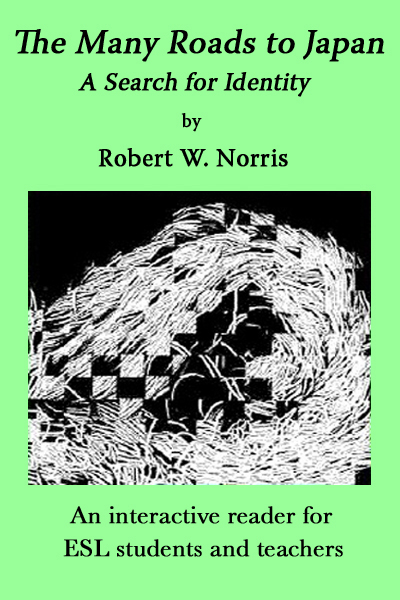
Home About Robert CV The Good Lord Willing and the Creek Don't Rise: Pentimento Memories of Mom and Me Media Kit Novels Reviews ESL Papers (can be viewed online by clicking on titles) The Many Roads to Japan (free online version for ESL/EFL teachers and students) Contact      |
Robert W. Norris 1999. In Bulletin of Fukuoka International University No. 1: 41-48 Introduction Teachers of composition or writing classes in Japanese colleges and universities are generally faced with students who have acquired a certain amount of English vocabulary and grammar, but have rarely put that knowledge to practical use (Wachs, 1993). In many cases, the major portion of these students' English education has been filled with translating words, phrases, and sentences from Japanese to English with often very strange results. The challenge for the composition teacher is to find ways to activate in a meaningful way the passive knowledge the students possess, as well as to help the students become more proficient while working to eliminate some of their more common errors. This paper takes a look at a writing program that I have developed over several years of trying to meet that challenge. The program has been well received by its students, and has proved to me that writing classes can and should be active, enjoyable, and beneficial to both teacher and students. The program is comprised of four main parts: (1) recognition of and working toward elimination of common errors, (2) the teacher's role in fostering classroom atmosphere, (3) error lists and using what Smith (1977) calls "extended descriptions1" to raise students' consciousness of selected grammatical patterns, and (4) an easy-to-use, error-marking system. Each of these parts is described in the following sections. The paper concludes by restating the effectiveness of the program. Common Errors Having taught in Japan for 15 years and compiled many lists of common errors (taken from both conversation and writing classes) made by Japanese students of English, I have noticed a definite consistency among error types. Many of these errors seem to show a strong first language (L1) transfer. This may be due in part to the students having been drilled heavily in word-by-word grammar-translation in their high school years. Although some researchers (see, e.g., Odlin, 1989: 15-48) say that L1 transfer plays a minimal role in second language (L2) acquisition, a case can be made for Japanese as a topic-prominant2 L1 having a strong degree of negative transfer in the acquisition of English as a foreign language (see, e.g., Kimizuka, 1967; Horiuchi, 1978; Kanaguchi, 1978; and Taylor, 1979). It is not, however, the purpose of this paper to pinpoint the reasons behind the errors. I only point out that they have been consistent through my years of exposure to Japanese students' production of English and need to be addressed. Although the types of common errors made by Japanese students of English are too numerous to be addressed in a class that meets no more than 28 times a year, attention can be given to the most glaring types. The most common error types (and examples) that I pay attention to in my writing classes are listed below. 1. "Be" verb problems,
especially (a) the use of the nonexistent "'be' verb +
dictionary form of another verb" pattern and (b) the
lack of agreement between the subject and noun
complement in the "'be' verb + noun" pattern
a. "I was belong to the
volleyball club in high school."
b. "My brother is junior high school." 2. Wrong usage of the
passive and active voices
a. "I was enjoyed the
movie."
b. "The library sometimes used for sleeping." 3. Omission of verbs after
the auxiliary "can"
a. "He can English very
well."
b. " I cannot piano." 4. Wrong usage or omission
of prepositions
a. "Winter holiday
starts at December 24th."
b. "I stayed hotel one night." 5. Wrong usage of articles
a. "I gave the book to a
my friend."
b. "Japan is not the big country." 6. Lack of subject-verb
agreement
a. "She walk to school
every day."
b. "Every movie star are handsome." 7. Starting too many
sentences with conjunctions
a. "I like music. And I
like dancing. And I like cake."
b. "I brought my umbrella. Because it was raining. So I'm not wet." 8. Wrong usage of the
present and past participles in such verbs as
"interest," "excite," "surprise," etc.
a. "I am interesting in
American culture."
b. "The game was very excited." With the above problem areas in mind, activities that give the students practice in correct usage within a meaningful context should be used. Creating a comfortable classroom atmosphere is extremely important if the students are to gain anything from the selected activities and retain what they are learning. The importance of the social climate of the classroom and the teacher's role in fostering it has been well-documented. In research conducted at UCLA the ESL (English as a Second Language) faculty chose social climate as the most important among 11 factors relating to language teaching (Bailey, 1976). Hunter (1974) has suggested that the teacher is the most important variable in the classroom. In reviewing literature on teacher effectiveness, Brophy and Good (1974) found that teacher warmth and enthusiasm consistently show a positive correlation with student achievement. Bailey and Celce-Murcia (1979: 316) maintain that "what the teacher says and does is so significant in establishing classroom atmosphere that it can outweigh the effects of materials, methods, and educational facilities." What does creating an atmosphere where affective filters3 are lowered and meaningful learning can take place have to do with setting up activities designed to help eliminate some of the problem areas listed previously? It means the teacher should use activities that include him in the community of the classroom, and that he should take an active role in the interaction of the community members. The activities should involve exchanges of information concerning the members' own lives, feelings, hopes, dreams, and opinions, as well as frequent usage of the patterns the students have problems with. In my writing classes a repetitive, four-week cycle of activities designed to encourage a feeling of community membership and interaction is used. The first two weeks of the cycle involve small group work and information-gap interviews based on sentence-level patterns. These classes are followed by one class of letter or composition writing. The fourth class of the cycle is one of error correction in which about 20 sentences with common errors taken from student papers are first corrected by the students in small groups during the first half of the class; in the second half I give a lecture on where the errors are and what a native speaker's reactions to them might be. Sentence-Level Activities Some sentence-level activities (and their focal areas) that have worked well in my writing classes are described in the following paragraphs. 1. "Which Do You Prefer and Why?" (Ur, 1988: 72): Write on the board 10 sets of two or three words expressing concepts likely to arouse positive or negative reactions (e.g., snakes, spiders, crocodiles; mornings, afternoons, evenings; mud, sand, rocks; etc.). Ask the students to express and justify their preferences (e.g., "I prefer snakes to spiders because they are more colorful and graceful."). This activity can be done in the first person or in an interview format in which students write sentences reporting on their classmates' preferences. It is a good activity for practicing usage of comparative forms of adjectives; singular, plural, and generic nouns; subject-verb agreement; and "be" verb patterns. 2. "Sweet Consequences" (Hadfield, 1990): Cut up about 40-50 strips of "reason" phrases and "consequence" phrases (e.g., "I brought my umbrella" and "it was raining"). Put the students into small groups and have them match the phrases in 20-25 "so" sentences and 20-25 "because" sentences (e.g., "It was raining so I brought my umbrella" or "I brought my umbrella because it was raining."). This activity is good for raising students' consciousness of the usage of subordinating conjunctions, as well as for helping reduce their tendency to start too many sentences with conjunctions. 3. "The Big 'If'": Hand out copies of a picture that shows several accidents about to happen that could set off a chain of events (e.g., a girl about to step on a banana peel, a car coming around a corner where a pedestrian is crossing the street, a window cleaner about to knock over a bucket of water on some people below him, etc.). Put this pattern on the board: "If + subject (relative clause) + present tense, subject + modal of probability + dictionary form of verb." Have the students (in pairs or small groups) make sentences describing what might happen in the picture. The students must write at least three more possible consequences of the first "if" (e.g., "If the girl who is walking in the right side of the picture steps on the banana peel, she will fall down. If she falls down, she might break her arm. If she breaks her arm, she might go to a hospital, meet a handsome doctor, fall in love, and get married."). This activity provides practice of the first conditional, relative clauses, modals of probability, and subject-verb agreement. 4. "Before and After" (Ur, 1988: 198-201): Hand out a picture of a room that needs to be cleaned. Have the students in small groups make a list of all the things that should be done (e.g., "The TV should be turned off." "The bed needs to be made." etc.). Hand out a second picture showing the room after it has been cleaned. There should be at least two new items in the room. Have the groups make a second list of what has been done (e.g., "The TV has been turned off." "A picture has been hung on the wall."). This activity provides practice in modals of necessity, present perfect tense, passives, and definite and indefinite articles. It is especially useful for showing students that when new information is introduced, the indefinite article "a" is often used. The main considerations for using such activities are that the activities should focus on common errors at the sentence level, encourage student creativity and input, and allow for student interaction and problem-solving. The teacher should walk around the classroom giving help, making suggestions, and joining in from time to time. Letters and Compositions After two weeks of sentence-level activities, in the third week I use a mixture of letter writing and free composition based on themes designed to elicit frequent repetition of certain patterns and verb tenses. For example, "A Trip I Have Taken" elicits frequent usage of the past tense, "A Person I Respect" elicits frequent usage of the present tense, etc. In order to encourage student production when writing letters and compositions, it is important for the students (a) to feel they are writing to communicate something to someone and (b) to have a clear idea of what information should be included in the paper. For the first of these two requirements, the students can be asked to address the letters "Dear (name of teacher)" in order to create a "pen pal" atmosphere. The teacher can then write brief comments at the end of the student papers and create an ongoing dialogue with the individual students throughout the year. These comments should be addressed to the students' ideas and experiences. For example, such comments as "I'm sorry your cat died and I hope she is in cat heaven now," "I had the same thing happen to me once," and "Your uncle sounds like a very interesting person" can be effective in encouraging future output, as well as in showing the students they have a real audience. Walter (1987: 11) elaborates:
It is strongly recommended that the teacher keep notes on his comments to students (as well as on student interests and concerns) so he can refer to them while walking around the classroom giving individual instruction when the students are engaged in an activity. Comments such as "Did you see where Matsui hit another home run last night?" "How are you doing at driving school?" and "Is your father recovering from his accident?" can go a long way toward establishing a comfortable, non-threatening environment and solidifying the ongoing dialogue between teacher and students. Meeting the second requirement of giving the students a clear idea of what information to include in their letters is simple. Rather than just stating a theme, the teacher should also write on the board a list of details to include. For example, if the students are writing about a pet they have kept, the following list could help stimulate ideas.
Stimulating pictures or lead paragraphs should also be used to help the groups get started. The teacher should encourage humor, fantasy, and digression in these papers. As most if not all students in freshman writing classes will not be required to perform in a western academic environment, and thus will not need to be proficient in the "linear, deductive, western expository style of writing" (Grohe, 1988), emphasis during these composition activities should be on creative writing. Grohe (1988) gives four reasons for this emphasis:
One final point about letters and compositions is that much of the work should be done in class. In this way, the teacher can walk around and give help where it is needed and maintain the ongoing dialogue that is important for classroom atmosphere and motivation. Error Lists and the Teacher Lecture Error lists form the central component of the writing program. Their use is designed to facilitate students' grammar consciousness-raising by the use of extended descriptions. The system for using the error lists is simple. Concentrating on the types of common errors outlined earlier, the teacher takes about 20 examples of these errors from the student papers, makes a list, and hands out copies of the list in the fourth class of the cycle. In order to retain the anonymity of the writers and avoid singling anyone out, changes in verbs and nouns can easily be made. During the first half of the class the students work in small groups discussing and trying to correct the errors. During the second half of the class the teacher gives a lecture on the errors. The lecture is intended to be filled with as much humor as possible. This humor is derived from what a native speaker's reactions might be to some of the error-ridden sentences on the list. Below are some typical errors taken from student papers and examples of how a teacher might present them. 1. "My family is four": The teacher demonstrates a native speaker's reaction: "That's interesting. What an unusual family you have. Let's see. Your father is four years old. Your mother is four years old. Your brother is four years old. Everyone is four years old! How did you get to be 18 years old?" The teacher then explains the error and writes the correct sentence on the board (e.g., "There are four people in my family."). 2. "Son is elementary school": The teacher draws a woman, two little girls, and a building on the board, then writes a name by each figure. He acts out a conversation with an imaginary stranger: "Hello, Mr. Smith. I'd like you to meet my family. This is my wife Sally (pointing to the woman figure). These are my two daughters Betty and Sue (pointing to the girl fugures). And this is my son John (pointing to the building figure). He is an elementary school!" The teacher then explains the error and writes the correct sentence on the board (e.g., "My son is an elementary school student."). 3. "He was died his wife": The teacher writes these sentences on the board: "He was killed by his wife." "His wife was killed by him." "He killed his wife." "His wife killed him." "He was dead, but now he is alive." "His wife was dead, but now she is alive." "He died." "His wife died." The teacher acts out an exchange betwen person A, who says, "He was died his wife" and person B, who goes through all the possible interpretations, becomes increasingly frustrated, and finally begins jumping up and down shouting, "Who died?" The teacher falls to the ground with a fake heart attack, gets up, smiles at the class, and says "His wife died." There is a method to this madness. First of all, humor is often an underused and unexpoited variable in creating a positive classroom atmosphere. Bailey and Celce-Murcia (1979: 318) encourage the use of humor:
In giving the lecture, it is not necessary to inject humor into the correction of each error on the list. The important thing is to use humor as a teaching tool where applicable. Most errors, however, lend themselves to a variety of possible interpretations. Any teacher should be able to come up with a few humorous explanations within a single list of errors. There is one point the teacher must always keep in mind. It is essential not to turn his interpretations into any kind of condescending or derogatory comment. Errors should always be seen as learning tools. The message to the students should be that errors are a natural part of learning and everyone makes them. If a positive atmosphere has been created and the teacher is seen as enjoying his experience with the students, it is unlikely any negative and unwanted impressions will be derived from the use of humor in correcting errors. In addition to using humor during the lecture, I strongly recommend using extended descriptions of the grammar points being emphasized. An example of an extended description in relation to the "be" verb problems mentioned earlier is shown below. The teacher puts the following on the board: a. subject + "be" +
adjective
b. subject + "be" + ing c. subject + "be" + past participle d. subject + "be" + preposition e. subject + "be" + noun (subject and noun must be the same) f. subject + "be" + dictionary form of regular verb (doesn't exist) In the case of "f," students are told this pattern does not exist in English. If they find an example of this pattern in their papers (e.g., "I was belong to the volleyball club in high school"), they should eliminate the "be" verb and, if it was conjugated, conjugate the regular verb (as in "I belonged to the volleyball club in high school"). Error-Marking System From the start of the second letter or composition, the teacher can begin introduction of a simple error-marking system to be used in conjunction with his comments of encouragement and praise written on the student papers. Errors on the error lists are put in numerical order. For example, the first list might be numbered 1-20, the second 21-40, the third 41-60, etc. The errors on the lists should be of the repetitive and common types discussed previously. As each error is discussed in the teacher's lecture, he should mark it as representative of one of those common types. As time goes by, the number of examples of a single type of error will naturally increase. It thus becomes easy for the teacher, when marking student papers, to circle the most troublesome errors and write the representative marks that have appeared on the error lists the students have in their possession. The students are then able to review their notes and make their own corrections. Rivers (1981: 307-308) emphasizes the importance of an easy-to-use correction system.
Psychological and psychologically oriented experimental research seems to indicate that for all types of learners, the maximum use of extra visual devices (over and above the words of the language per se) is necessary for unimpeded effective learning to take place....Maximizing visual representations to accompany, illustrate, and explain linguistic items may well improve learning a great deal.... Conclusion This paper has described some of the common errors that students in Japanese university writing classes make and a suggested writing program based on activities designed to give students practice in these problem areas. The program is meant to be carried out in a comfortable, non-threatening atmosphere in which students can make positive steps toward reducing their errors and increasing their motivation to write in English. The program revolves around a repetitive four-week cycle. The first two weeks of the cycle involve the students in sentence-level activities designed to activate their passive knowledge and give them practice with problem structures. The third week has the students writing letters or compositions that elicit their experiences and ideas and that require frequent usage of certain structures and tenses. The fourth week involves the students in group correction of errors and has the teacher give a lecture on the same errors. The focal points of the program are the teacher's influence on classroom atmosphere, the use of humor and extended descriptions when explaining grammatical points and errors, and a simple, error-marking system for use on student papers. In the last class of the year I always have the students fill out a questionnaire about how much they think they have learned, what they have enjoyed or disliked about the class, and what they think are the strong and weak points of the class. To date, the comments in these questionnaires have been decidedly favorable. Throughout my years of using the writing program, more than 70 percent of the students have marked either "a lot" or "more than average" (the other answer categories are "an average amount," "less than average," "not much," and "nothing") in answer to the question "How much do you think you learned in this class?" For teachers who don't feel uncomfortable in the role of occasional entertainer, have a commitment toward creating an atmosphere in which affective filters are lowered, and sincerely enjoy the time spent with students, the writing program outlined in this paper can be effective in raising students' consciousness of troublesome grammatical patterns, reducing the number of common errors they make, and improving their English writing ability. NOTES 1. Smith (1977) distinguishes between two kinds of pedagogically oriented language descriptions in reference to pedagogical grammar and the matter of by what means and in what form information about language and language learning teachers should be imparting to students. One kind is extended descriptions, or "on-line grammatical information tailored to the exigencies of particular learning situations." The other kind is concentrated descriptions, or "metalinguistic statements or observations exclusive of learner variables." 2. "Topic-prominant" refers to languages such as Mandarin, Chinese, Japanese, and Korean that, according to Rutherford (1987), have "topic-comment" as the basic sentence constituent type. Topic-comment is contrasted with "subject-predicate," which is what English has as its basic sentence constituent type. 3. Krashen's (1981, 1982) Theory of Second Language Acquisition incorporates the notion of the Affective Filter as proposed by Dulay and Burt (1977). The filter controls how much language input the learner is open to and how "deep" the input reaches. Learners with high motivation and self-confidence and with low anxiety have "low filters." REFERENCES Bailey, K. 1976. The Use of Two Observation Instruments in Supervised ESL Teaching. Unpublished MA thesis. University of California, Los Angeles. Bailey, K. & Celce-Murcia, M. 1979. Classroom skills for ESL teachers. In M. Celce-Murcia & L. McIntosh (Eds.), Teaching English as a Second or Foreign Language (pp. 315-330). Rowley, Mass.: Newbury House. Brophy, J. & Good, T. 1974. Teacher-Student Relationships: Causes and Consequences. New York: Holt, Rinehart, & Winston. Butler, J. 1980. Remedial writers: The teacher's job as a corrector of papers. College Composition and Communication, 31: 270-277. Dulay, H., & Burt, M. 1977. Remarks on creativity in language acquisition. In M. Burt, H. Dulay, & M. Finocchiaro (Eds.), Viewpoints on English as a Second Language. New York: Regents. Grohe, W. 1988. What type of writing should we teach our Japanese students? The Language Teacher, 12(11): 51-55. Hadfield, J. 1990. Advanced Communication Games. Hong Kong: Thomas Nelson & Sons. Horiuchi, K. 1978. Error analysis: Error analysis and common errors in English. In I. Koike, M. Matsuyama, Y. Igarashi, & K. Suzuki (Eds.), The Teaching of English in Japan (pp. 762-769). Tokyo: Eichosha. Hunter, M. 1974. Piagetian Theory Applied to Assessment of the Teaching Process. Unpublished manuscript. University Elementary School, University of California, Los Angeles. Kanaguchi, Y. 1978. Error analysis: Mistakes commonly made by Japanese. In I. Koike, M. Matsuyama, Y. Igarashi, & K. Suzuki (Eds.), The Teaching of English in Japan (pp. 770-780). Tokyo: Eichosha. Kimizuka, S. 1967. Teaching English to Japanese. Los Angeles: Anchor Enterprises. Knoblauch, C. H. & Brannon, L. 1981. Teacher commentary on student writing: The state of the art. Freshman English News, 10: 1-4. Krashen, S. 1981. Second Language Acquisition and Second Language Learning. Oxford: Pergamon. Krashen, S. 1982. Principles and Practice in Second Language Acquisition. Oxford: Pergamon. Leki, I. 1990. Coaching from the margins: Issues in written response. In B. Kroll (Ed.), Second Language Writing: Research Insights for the Classroom. Cambridge: Cambridge University Press. Moskowitz, G. 1976. The search for excellence. Paper presented at the tenth annual TESOL convention. New York. Moskowitz, G. & Hayman, J. 1974. Interaction patterns of first year, typical and "best" teachers in inner-city schools. Journal of Educational Research, 67: 5. Odlin, T. 1989. Language Transfer: Cross-Linguistic Influence in Language Learning. Cambridge: Cambridge University Press. Rivers, W. 1981. Teaching Foreign-Language Skills (2nd Edition). Chicago: University of Chicago Press. Rutherford, W. E. 1987. Second Language Grammar: Learning and Teaching. New York: Longman. Smith, M. S. 1977. Aspects of Future Reference in a Pedagogical Grammar of English. Frankfurt/Main: Lang. Smith, M. S. 1988. Applied Linguistics and the psychology of instruction: A case for transfusion? In W. Rutherford & M. S. Smith (Eds.), Grammar and Second Language Learning (pp. 206-223). New York: Newbury House. Taylor, H. M. (Ed.). 1979. English & Japanese in Contrast. New York: Regents Ur, P. 1988. Grammar Practice Activities: A Practical Guide for Teachers. Cambridge: Cambridge University Press. Wachs, S. 1993. Breaking the writing barrier: Approaches to the composition class. In P. Wadden (Ed.), A Handbook for Teaching English at Japanese Colleges and Universities. Oxford: Oxford University Press. Walter, C. 1987. Teaching writing: Putting form last. The Language Teacher, 11(12): 10-11. |